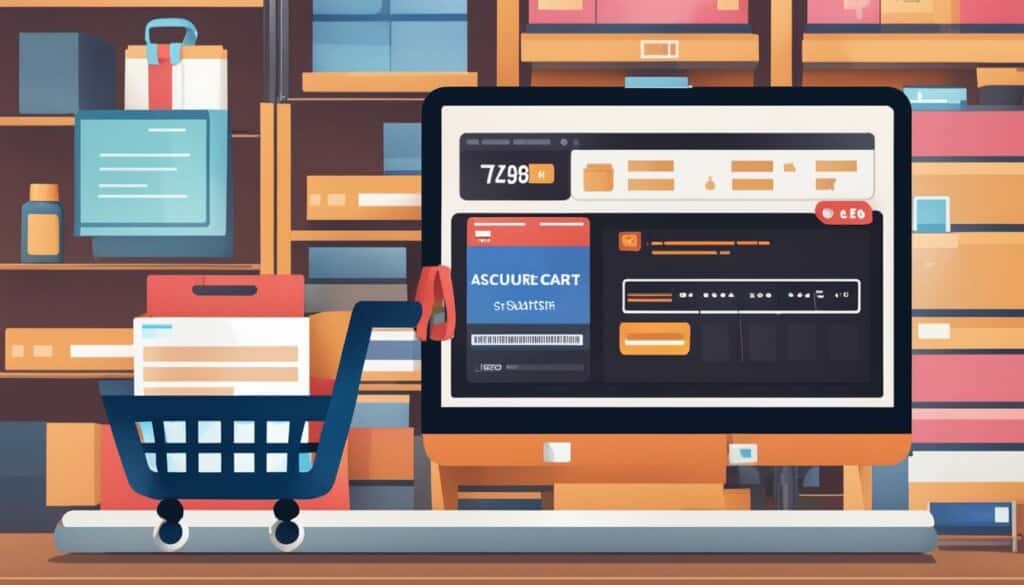Table of Contents
E-commerce, or electronic commerce, is the buying and selling of goods and services over the internet. It encompasses various types of transactions such as business-to-business (B2B), business-to-consumer (B2C), consumer-to-consumer (C2C), and consumer-to-business (C2B). Popular e-commerce platforms like Amazon and eBay have contributed to significant growth in online retail.
During the COVID-19 pandemic, the percentage of retail sales accounted for by e-commerce reached 16.5%. E-commerce offers benefits such as availability, accessibility, speed of access, wide product selection, and international reach, making it a crucial element in the online trading sector. However, it also presents challenges, including limited customer service, inability to physically touch products before purchase, and shipping wait times. Its impact on global commerce is undeniable.
What is e-commerce?
E-commerce, also known as electronic commerce, refers to the buying and selling of goods and services or the transmission of funds or data over an electronic network, primarily the internet. It encompasses a wide range of transactions and can involve businesses or individuals. E-commerce can be classified into different types, including B2B, B2C, C2C, and C2B, depending on the parties involved in the transactions. E-commerce platforms like Amazon and eBay have played a significant role in the growth of online retail.
Electronic commerce, commonly known as e-commerce, is the process of buying and selling goods and services over an electronic network, typically the internet. It involves various transactions conducted between businesses, individuals, and consumers. E-commerce has evolved to encompass different types, including Business-to-Business (B2B), Business-to-Consumer (B2C), Consumer-to-Consumer (C2C), and Consumer-to-Business (C2B) exchanges. Notable e-commerce platforms such as Amazon and eBay have played a pivotal role in shaping the online retail industry.
E-commerce has transformed the way businesses operate and consumers shop. It provides convenience, accessibility, and a vast selection of products and services. With just a few clicks, customers can purchase items from around the world and have them delivered to their doorstep. Online platforms connect buyers and sellers, facilitating seamless transactions and creating new opportunities for businesses to thrive. The growth of e-commerce has been fueled by advancements in technology, secure payment gateways, and improved logistics networks.
Types of E-commerce
E-commerce can be categorized into different types based on the parties involved in the transactions:
- B2B (Business-to-Business): In this type of e-commerce, businesses conduct transactions with other businesses. It involves the sale of goods or services between suppliers, manufacturers, wholesalers, or distributors.
- B2C (Business-to-Consumer): B2C e-commerce involves businesses selling products or services directly to individual consumers. It is the most common type of e-commerce and includes online retail stores, such as Amazon and eBay.
- C2C (Consumer-to-Consumer): C2C e-commerce facilitates transactions between individual consumers. Online classifieds, auction platforms, and peer-to-peer marketplaces are examples of C2C e-commerce.
- C2B (Consumer-to-Business): C2B e-commerce is when consumers offer goods or services to businesses in exchange for payment. Freelancing platforms and influencer marketing are examples of C2B transactions.
E-commerce has revolutionized the way businesses and individuals buy and sell goods and services. It has expanded market reach, simplified transactions, and created new opportunities for entrepreneurs and consumers alike. As technology continues to advance, e-commerce is expected to further grow and reshape the global economy.
How does e-commerce work?
E-commerce, which stands for electronic commerce, operates through the internet, enabling customers to access online stores using their devices. When a customer places an order, their web browser communicates with the server hosting the e-commerce website. This data is then transmitted to various systems and databases involved in the e-commerce process. These systems include inventory management, payment processing, and banking systems, which facilitate seamless transactions and data communication.
Once the order is validated, the order manager sends a notification to the customer and initiates the order fulfillment process. The product or service is then prepared for dispatch and delivered to the customer’s specified location. This entire process is facilitated by the integration of various technological systems that ensure smooth and efficient operations.
E-commerce platforms encompass a range of solutions, including online marketplaces, software as a service (SaaS) tools, and open-source tools developed in-house. These platforms provide businesses with the necessary infrastructure and features to manage online stores, process orders, and streamline payment processing.
By leveraging the power of the internet and advanced technological systems, e-commerce has revolutionized the way businesses conduct transactions and interact with customers. It has reshaped the retail landscape, offering numerous benefits for businesses and consumers alike.

| Advantages of e-commerce | Challenges of e-commerce |
|---|---|
| 1. Around-the-clock availability | 1. Limited customer service |
| 2. Speed of access | 2. Inability to physically assess products |
| 3. Wide product selection | 3. Shipping wait times |
| 4. Global reach | 4. Security issues |
| 5. Lower cost | |
| 6. Personalization |
Types of E-commerce
In the world of e-commerce, various types of transactions take place, involving different parties. Let’s explore the different categories:
B2B (Business-to-Business)
In B2B e-commerce, businesses engage in transactions with other businesses. It involves the exchange of goods, services, or information between companies, such as manufacturers selling their products to wholesalers or retailers purchasing inventory from suppliers.
B2C (Business-to-Consumer)
B2C e-commerce occurs when businesses sell products or services directly to consumers. In this model, customers can browse, select, and purchase items on websites or mobile applications. Well-known examples of B2C e-commerce include online retailers like Amazon and fashion brands selling directly to customers through their websites.
C2C (Consumer-to-Consumer)
C2C e-commerce enables individual consumers to sell products or services directly to other consumers. It eliminates the need for intermediaries and allows individuals to transact with one another. Online platforms like eBay and classified advertisement websites facilitate C2C transactions, empowering individuals to buy and sell items to fellow consumers.
C2B (Consumer-to-Business)
In C2B e-commerce, individual consumers offer products or services to businesses. This model often involves freelancers, consultants, or independent contractors providing their expertise to companies. Examples of C2B transactions include photographers selling their photographs to businesses for commercial use or influencers collaborating with brands for sponsored content.
B2A (Business-to-Administration)
B2A e-commerce refers to online transactions between businesses and government administrations. It involves businesses interacting with government entities, agencies, or organizations for various purposes, such as submitting tax forms, applying for licenses, or participating in government procurement processes.
C2A (Consumer-to-Administration)
In C2A e-commerce, individual consumers engage with government administrations through online platforms or portals. This interaction can include activities like paying taxes, renewing passports, or requesting government services electronically.
Mobile Commerce
With the growing prevalence of smartphones, mobile commerce has emerged as a significant subset of e-commerce. Mobile commerce, or m-commerce, refers to online transactions conducted through mobile devices, such as smartphones and tablets. It allows consumers to shop on the go, leveraging mobile applications or mobile-optimized websites.
Understanding these different types of e-commerce is crucial for businesses and consumers to navigate the digital marketplace effectively. Each category offers unique opportunities and challenges, highlighting the diverse ways in which e-commerce facilitates economic transactions.
Advantages of e-commerce
E-commerce offers numerous benefits that have transformed the way we shop and conduct business online. From around-the-clock availability to a wide selection of products, e-commerce has revolutionized the shopping experience.
- Around-the-clock availability: One of the key benefits of e-commerce is that it allows businesses to operate 24/7, offering customers the convenience of making purchases anytime, anywhere. Whether it’s a late-night shopping spree or a quick purchase during a lunch break, e-commerce ensures that products and services are available at all hours.
- Speed of access: With just a few clicks, customers can access e-commerce websites and browse through a vast catalogue of products. This eliminates the need to visit physical stores, saving time and effort. Additionally, e-commerce platforms often provide search filters and product recommendations, making it easier for customers to find what they’re looking for quickly.
- Wide selection: E-commerce offers an extensive variety of products, ranging from clothing and electronics to books and home goods. With a few simple searches, customers can explore diverse options and compare prices, ensuring they find the best deal.
- International reach: Unlike traditional brick-and-mortar stores, e-commerce has no geographical boundaries. It allows businesses to reach customers globally, expanding their customer base and increasing sales potential. This international reach offers opportunities for both businesses and customers to engage in cross-border transactions.
- Lower cost: E-commerce eliminates the need for physical storefronts, reducing overhead costs such as rent and utilities. These savings can be passed on to the customers, resulting in lower prices for products and services. Additionally, online discounts, promotions, and comparison tools enable customers to find the best deals and save money.
- Personalization: E-commerce platforms leverage customer data to provide personalized shopping experiences. Through algorithms and user profiles, businesses can offer product recommendations and tailored promotions, enhancing customer satisfaction and increasing the likelihood of repeat purchases.
These advantages make e-commerce an attractive option for businesses and customers alike. The ability to shop anytime, access a wide range of products, and enjoy international reach while saving time and money has propelled the growth of e-commerce in recent years.
Disadvantages of e-commerce
While e-commerce offers numerous advantages, it is not without its drawbacks. It is essential to consider these disadvantages when engaging in online trading.
Limited customer service
E-commerce platforms often rely on automated systems, resulting in limited customer service options for shoppers. Unlike traditional brick-and-mortar stores, customers may face challenges in getting personalized assistance or addressing specific concerns. This limited support can lead to frustration and dissatisfaction, affecting the overall shopping experience.
Inability to physically assess products
One significant disadvantage of e-commerce is the inability for customers to physically assess products before making a purchase. In traditional retail, customers can touch, feel, and try products, ensuring their quality and suitability. In contrast, online shoppers have to rely on product descriptions, images, and customer reviews, which may not always provide a complete understanding of the item’s properties or appearance.
Shipping wait times
While many e-commerce platforms strive to offer fast shipping, there can still be delays due to various factors. Customers may experience longer wait times for delivery, which can be frustrating, especially when compared to the instant gratification of purchasing from a physical store. Additionally, international shipping can introduce additional delays and uncertainties.
Security issues
E-commerce transactions involve the exchange of sensitive information, such as credit card details and personal data. Despite advancements in security measures, there are still risks of data breaches and unauthorized access to customer information. Cybercriminals can exploit vulnerabilities in e-commerce platforms, potentially compromising the security and privacy of customers. This can lead to financial losses and identity theft, eroding trust in online shopping.
As with any form of commerce, it’s important for consumers and businesses to be aware of the potential risks and take appropriate measures to mitigate them.
By understanding and addressing these disadvantages, both businesses and consumers can navigate the e-commerce landscape more effectively, achieving a balance between convenience and mitigated risks.

Conclusion
E-commerce has revolutionized the way businesses operate and consumers shop in the modern world. With the convenience it offers, businesses can reach customers anytime, anywhere, eliminating the limitations of traditional brick-and-mortar stores. It opens up a world of opportunities for online business owners to showcase their wide range of products and services to a global audience, breaking through geographical boundaries.
However, e-commerce also presents its fair share of challenges. The limited customer service can sometimes leave consumers with unanswered questions or concerns. Additionally, the inability to physically assess products before purchase can be a drawback for some customers. Security concerns, such as online fraud and data breaches, are also challenges that businesses need to address to build trust with their customers.
Despite these challenges, understanding the nuances of e-commerce and leveraging its numerous benefits can position businesses for success in the online marketplace. The around-the-clock availability and speed of access to products and services give businesses a competitive edge. The ability to cater to a vast array of consumer preferences and the potential for personalization offer opportunities to create unique shopping experiences. Moreover, the lower cost of operation compared to traditional businesses allows for better pricing and profitability.
By embracing e-commerce, businesses can expand their customer base, increase sales, and adapt to changing consumer demands. The key lies in implementing effective customer service strategies, investing in secure payment gateways, and continuously improving the online shopping experience. As e-commerce continues to evolve and reshape the business landscape, businesses that embrace the benefits and meet the challenges head-on will thrive in the digital age.
FAQ
What is e-commerce?
E-commerce, or electronic commerce, refers to the buying and selling of goods and services or the transmission of funds or data over an electronic network, primarily the internet.
How does e-commerce work?
E-commerce operates through the internet, where customers access online stores using their devices. When a customer places an order, their web browser communicates with the server hosting the e-commerce website. This data is then relayed to various systems and databases, including inventory management, payment processing, and banking systems. Once the order is validated, the order manager notifies the customer, and the product or service is dispatched to the customer.
What are the types of e-commerce?
E-commerce can be categorized into different types based on the parties participating in the transactions. These include business-to-business (B2B), business-to-consumer (B2C), consumer-to-consumer (C2C), and consumer-to-business (C2B) e-commerce.
What are the advantages of e-commerce?
E-commerce offers several advantages, including around-the-clock availability, speed of access, wide product selection, international reach, lower costs, and personalization.
What are the disadvantages of e-commerce?
Despite its benefits, e-commerce also has some disadvantages, including limited customer service, inability to physically assess products before purchase, shipping wait times, and security issues.
How has e-commerce impacted global commerce?
E-commerce has revolutionized the way businesses operate and consumers shop. It offers convenience, a wide range of products, and global reach. However, it also presents challenges such as limited customer service and security concerns.







